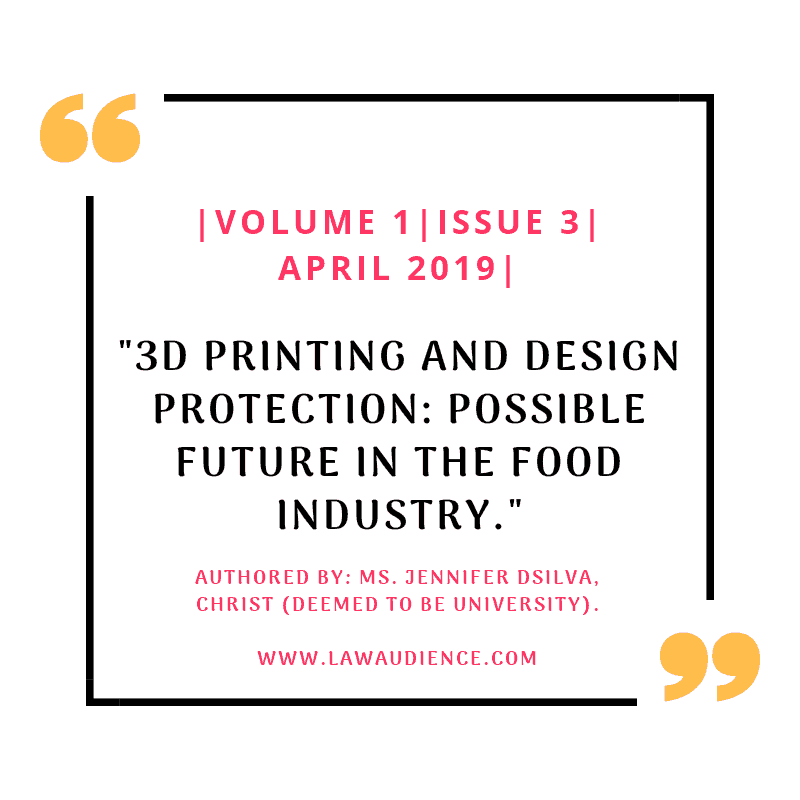AUTHORED BY: MS. JENNIFER DSILVA, CHRIST (DEEMED TO BE UNIVERSITY), BENGALURU, KARNATAKA.
I. ABSTRACT:
“The invention of 3D printers has impacted various industries for good. These industries have used these 3D printers to make production easier in case of factories. It is also seen that with the change of material 3D printers can create more than just plastic products. This was used in many fields including the food industry. With this technology of 3D printers, restaurants could replicate certain designs down to a spot. This helped in the precision and continues efficiency of presentation. Since presentation is a big part of the food industry, these 3D printers could make it easy for many restaurants to copy the designs. This can be seen as a problem in certain ways since chefs take time and use their talents to make their presentation of food look artistic, the copying of the same would be unfair to the chefs. Due to the many attributes that can ensure the food could not be presented the exact same way such a question was not asked. But now, with the use of 3D printers, the exact same presentation can be done. In order to analyse this and find a possible way to protect users of 3D printers in the food industry various intellectual property rights will be looked into. Also, these rights will be looked at from the context of Indian legislations and its possible application in such scenarios.”
II. INTRODUCTION:
In today’s world, technology is on the rise and this has impacted many fields. As seen, technology has made it convenient for many in terms of efficiency and speed. One such field includes 3D printers. With the use of 2D printers, it was noticed that there was a possibility of using printers to make 3D images. The innovative idea of making a printer that can print 3D images has given a chance for many industries to grow based on this technology. The use of this to make the exact same 3D product does benefit many industries.
Yet, along with this, there can be a few legal questions that can come to mind. When considering this technology, with the simple push of a button, 3D printers can create an exact replica of the original product. This can be an advantage in some industries when products are to be made in bulk and a violation of the right in cases where the owner of the design is not the one producing it. The field of intellectual property rights (IPR), which exclude persons from using another’s idea and protecting the rights of such user, help in such cases. But these rights exclude some fields of work and with this new technology can cause some violation of rights.
The food industry has faced some drastic development in recent years. The use of technology to help make food has increased, making the process of cooking easier. It is also seen that; 3D printers have been used in kitchens as well. Here, a potential problem could arise with regard to the presentation of food. Although it was established, that IPR cannot protect food; this development can be a debatable question. This paper will analyse the use of 3D printers along with the possibility of protection in the food industry in certain cases. This protection will mainly focus on the field of IPR and the possible protections it can provide.
III. DEVELOPMENT OF 3D PRINTING:
Looking at the history of 3D printers, it started in the early 1980s. The idea of 3D printers has been around for a while, but the main recognition and inventor of the same was Charles Hull, who asked for the first patent for stereolithographic.[1] Since then, such technology had taken over the market and various fields, this included developments that had happened into the 21st century, including bioprinters used in the field of medicine, and even in food. But this technology does not work the same as that of a regular printer. This printer needs a software called Computer Aided Design files or CAD’s to input the design to the printer in order for it to print. Hence, it is not as easy to use the 3D printer in comparison to the developed 2D printers. The inventors of 3D printers have used the same to not only print solid material but other material as well. When looking at how 3D printers work, such images are created as a result of melting polymer filament and shaping them into particular objects. This material can be changed to anything including food, making a 3D model of that design. These 3D printers are already protected under patent law, as they are inventions and the result of hard work of certain persons. The World Intellectual Property Rights Organisation (WIPO) has recognised the development different fields have with the help of 3D printers. It was in the year 2015 that WIPO had released a research working paper to explain the use of 3D printers.[2] This has got the attention of various fields of IPR.
One of the main questions with regard to 3D printing was the protection of CAD’s. Without the CAD’s, 3D printers would not be able to print and so it’s protection is important. It can be considered that CAD’s can be protected under copyright law. When looking at Section 14 of the Indian Copyright Act, 1957[3] the term ‘artistic works’ is defined. This definition includes the line ‘the work in any material form including depiction in three-dimensions of a two-dimensional work or in two-dimensions of a three-dimensional work’. Also looking at Section 2(d) of the Indian Designs Act, 2000[4], which states ‘ design means only the features of shape, configuration, pattern, ornament or composition of lines or colours applied to any article whether in two dimensional or three dimensional or in both forms, by any industrial process or means, whether manual, mechanical or chemical, separate or combined. These two provisions provide the scope for protection of CAD’s under their respective legislations.
It is very well known that there are instances where a particular product can be protected under more than one field of intellectual property. In this instance, it is the designs that are produced by the CAD’s. When considering the proper working of CAD’s, it is the one who makes the design that can have the right to exclude others from using the same. As explained above, CAD’s can be protected under either provision. The inclusion of three-dimensional products in either legislation can conclude that CAD’s can be protected either as copyright or as design. The protection of CAD’s is important in various fields, and this protection needed in the field of food will now be examined.
IV. 3D PRINTING AND THE FOOD INDUSTRY:
The various fields of 3D printing have been used in important. The impact of such technology has changed the field and made things easier. Looking at food, it is rarely understood, the amount of work that is put into a dish before it is served. Focusing on many aspects like flavour, the balance of the dish, but one of the most important aspects is the presentation. Food blogs have often posted on food that not only tastes the food but also the picture presentation of the food. The initial attractiveness of the food often adds to the experience of it. This important aspect will be discussed with a connection to 3D printers.
With this new technology introduced into kitchens, the making of dishes in a particular design is easier. This would increase the consistency in the presentation of dishes but, with the same input, design can be copied by others. When considering such an event before this technology, it is not possible that the exact dish’s design be copied in the exact same way. With the difference in the technique used and the precision and style being executed, may vary, this would not result in perfected copying.
Restaurants often have severe competition and one of the aspects for this is the presentation of food. The presentation of food may vary from restaurant to restaurant. Now with this use of CAD’s the copying of presentation is very easy. This would result in unfair use and infringement of the artistic design of the chefs. Chef’s put in a lot of work to ensure their food presentation is artistic and so the copying of the same can be considered an infringement to their right. When looking at such a situation, this technology can easily be used for infringement purposes. Yet, since the food industry is not protected on such grounds, such issues cannot be addressed.
V. POSSIBLE LEGAL DEVELOPMENTS:
In several instances, it was seen that the food industry cannot be protected under IPR. But this new development does bring about some new concerns. As explained above, the presentation of the food is very important and copying the same would be morally wrong. The protection of CAD’s has the possibility to be protected under Copyright Law and Design Law and in order for chefs to use these CAD’s their presentation must first be considered as artistic works under the law.
The term artistic work is defined under both the Designs Act and Copyright Act of India. To look into the possible application of copyright in these cases, artistic work is defined under Section 2 of the Indian Copyright Act. It states that artistic work can be considered as ‘any other work of artistic craftsmanship’.[5] This ‘other craftsmanship’ can include representing these designs in various mediums. This can also include food on the grounds that the craftsmanship of the food contributes to artistic designs. It can be considered that the CAD designs can be protected under Copyright Law. The design in itself is an artistic work and the maker of the same can protect it, also such protection is possible under the Designs Act as well. It is through such laws protection can be provided, hence helping protect the rights of chef’s when they use 3D printers.
VI. CONCLUSION:
According to the possible situations stated above, it is possible that 3D printers be taken advantage of. Though, such situations are not possible in every scenario, like in the case of curries where there is no form and there are only limited means of presentation. But with the possibilities of presenting other foods like desserts, presentations can be copied to the dot with 3D printers. The specific designs inputted into these CAD’s are provided protection to exclude others from using and profiting from their artistic design. In such instances, the same can be applied to the food industry and the same can be protected from being copied. The protection of such a field would encourage cooks to look at technology and optimize its use. With these concerns, it would be difficult for chefs to use this technology without the fear of being copied. Also, since such inputting of design files for CAD’s is not easily possible for the common man, they have to approach experts in order to get the same done. This should hence be protected by having the chefs draw the approximate design of the plating on a paper. This would help with the proper copyright owner of the CAD; the one having rights to use it to produce 3D objects.
This issue concerning 3D printings have not been put forward yet, but with its growing use, the same question can be brought up. When considering the Indian legislation of IPR, it can provide protection under the two legislations of the Designs Act and Copyright Act. Yet, it cannot be registered under both and so the owner has to decide under which the design has to be protected. This analysis showed the definition of artistic work under these legislations. This shows the possible future and impact of 3D printers. It shows its uses and possible problems that it can cause while showing possible remedies for it. This, hence, shows the future possibilities and impact of the 3D printer in the food industry.
[1] The History of 3D Printing: 3D Printing Technologies from the 80s to Today Posted By Hannah Bensoussan on Dec 14, 2016 https://www.sculpteo.com/blog/2016/12/14/the-history-of-3d-printing-3d-printing-technologies-from-the-80s-to-today/.
[2] 3D Printing and the Intellectual Property System by Stefan Bechtold available at https://www.wipo.int/edocs/pubdocs/en/wipo_pub_econstat_wp_28.pdf.
[3] Indian Copyright Act, 1957 Sec 14 (c) (1).
[4] Indian Designs Act, 2000, Sec 2(d).
[5] Indian Copyright Act, 1957, Sec 2(c).



